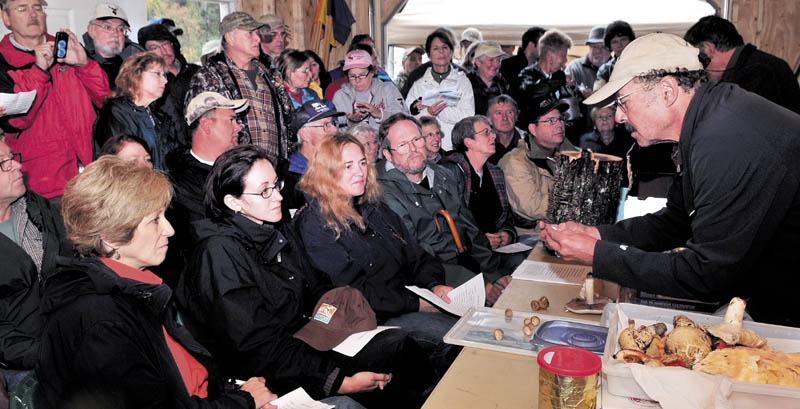WATERVILLE — A good walk rewarded is a mushroom hunt.
At least that’s how Richard Tory, of Canaan, a largely self-taught expert in wild mushroom foraging, sees it.
“You have to be curious and patient,” he said Sunday to an audience of about 50 people gathered at the Quarry Road Recreation Area for a workshop on identifying, gathering and cooking with wild mushrooms. “I’ve walked for hours looking for a single type of mushroom.”
The workshop, well attended despite rain, was sponsored by Kennebec Messalonskee Trails. Tory gave a presentation on some of his favorite books and mushroom guides, taught people how and when to look for wild mushrooms and introduced them to a few of his favorite types.
The first rule of mushroom hunting, he said, is to buy and use a good field guide. Tory recommends the “National Audubon Society Field Guide to North American Mushrooms” by Gary H. Lincoff, a book that he said is useful for both its descriptions and its pictures.
He also spoke about methodology for identifying mushrooms. One of the main ways to identify mushrooms is by cutting into one, seeing whether it bleeds and examining the gills.You also can place the mushroom on a white sheet of paper and put a cup over it for a few hours, causing it to release spores. The Audubon Society book contains a spore identification table that can help with that.
Tory talked about some of his favorite cookbooks for preparing mushrooms, including “The Mushroom Lover’s Mushroom Cookbook” by Amy Farges and the “Totally Mushroom Cookbook” by Helene Siegel.
The chances of finding a poisonous mushroom are slim, but Tory said it is always best to be cautious.
“The odds of picking a poisonous mushroom probably aren’t great,” he said. “There are poisonous mushrooms out there, but in comparison to the overall mushroom population, they are probably not a great percentage.”
There are a few pieces of advice to keep in mind when looking for and eating mushrooms. Tory said to make sure they are always cooked, eaten in moderation and foraged for ethically and honestly.
“Even if a mushroom isn’t poisonous, it could make you sick to your stomach if you aren’t used to eating them,” he said. “If you are trying a mushroom for the first time, just try a small piece.”
It is also important, he said, to leave some mushrooms for others.
In Maine, the peak season for mushrooms is late summer and fall. Tory said rainy, warm weather like Sunday’s is ideal.
“Next week should be good,” he said.
He then showed the audience mushrooms he had collected around the area, including flat yellow-bellied chicken mushrooms, deep-orange and coral-shaped lobster mushrooms and tiny white “puffballs.”
Valery Mamonov, 71, of Rome, brought a few mushrooms he had gathered in his own backyard to have Tory look at them.
“I’m not a big expert, but I wanted to see what he thought,” said Mamonov, who lived in Russia before coming to Maine and said he used to pick mushrooms there and cook with them.
“We learned some of the basic ones, and it really helped to be able to see the physical mushroom before we go out and try to find them,” said Jeff Dube, 42, of Rome. He was there with his wife, Lisa.
They said they had never foraged for mushrooms before but became interested after a friend said he had found mushrooms that he was able to sell near their home.
“We like to eat mushrooms,” said Lisa Dube, 42. “I know there are many poisonous ones, but I’m willing to try picking them once we get a book.”
Rachel Ohm — 612-2368
rohm@mainetoday.com
Send questions/comments to the editors.




Success. Please wait for the page to reload. If the page does not reload within 5 seconds, please refresh the page.
Enter your email and password to access comments.
Hi, to comment on stories you must . This profile is in addition to your subscription and website login.
Already have a commenting profile? .
Invalid username/password.
Please check your email to confirm and complete your registration.
Only subscribers are eligible to post comments. Please subscribe or login first for digital access. Here’s why.
Use the form below to reset your password. When you've submitted your account email, we will send an email with a reset code.